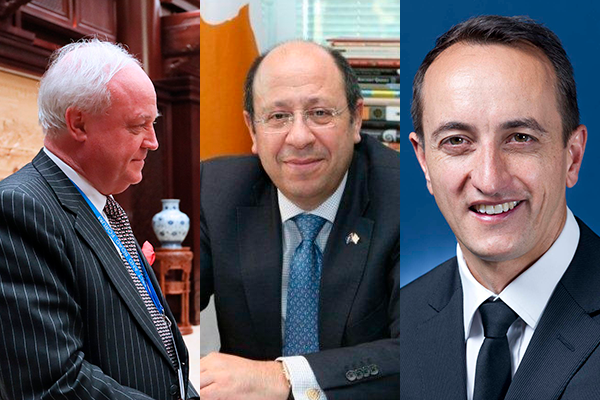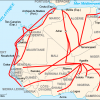Theme
Diplomacy in the Digital Age depends on how diplomats understand and transform online influence into tangible offline diplomatic influence.
Summary
The core mission of diplomacy in the Digital Age is still about finding the middle ground among the broadest possible audience but it needs several prerequisites. This ARI analyses three case studies that show that successful digital diplomacy requires a keen understanding of the online space in which the digital diplomat operates, a competent strategy to building and managing a well-designed ‘network of networks’ of followers and influencers, and a pro-active approach to connecting digital diplomatic outputs to tangible foreign policy outcomes so that online influence could be successfully converted into offline diplomatic influence (actions and policies).
Analysis
Commenting on the challenges that the Digital Age has generated for the craft of diplomacy, the former U.S. Secretary, John Kerry, provocatively remarked that “the term digital diplomacy is almost redundant –it’s just diplomacy, period.” For Kerry, digital technologies in general, and social media, do help advance states’ foreign policy objectives, bridge gaps between people across the globe, and engage with people around the world, but ultimately, they fulfil the same core diplomatic function that is, to create dialogue and find common ground among the broadest possible audience. After all, he claimed, “that’s what diplomacy’s all about”.1
Interestingly, Kerry made this remark in 2013 before the ‘dark side’ of digital technologies had the chance to disclose itself in various forms of digital disinformation, propaganda and info war. Five years later, it is worth asking whether Kerry’s statement still resonates: is digital diplomacy still capable of finding the common ground, and if so, how exactly? Three issues need to be unpacked to address this question. First, what are the main features of the process of digital transformation and why shall we take them seriously? Second, how these features have influenced the practice of diplomacy, both for better and for worse? And third, what lessons can we draw from existing cases of good practices of digital diplomacy and to what extent these lessons can be generalised to the digital activities of other embassies and Ministries of Foreign Affairs (MFA)?
Going Digital
The rise of digital diplomacy in the past decade cannot be separated from the technological context in which it has developed. Three features of the process of digital transformation stand out, among others, for understanding the evolution of digital diplomacy and the challenges it continues to face under the influence of the changing technological landscape. Speed is the first one and refers to the fast rate at which new digital technologies enter the market and the swiftness by which they are adopted by individuals, companies and institutions. For example, it has taken the telephone 75 years to reach 100 million users worldwide, but only 16 years and 4 ½ years to the mobile phone and its most popular app, Facebook, to pass the same milestone respectively.2 It is worth recalling that the mass adoption of smartphones and the spread of mobile internet was made possible by the launch of the third generation of wireless mobile telecommunications technology (3G) in early 2000. With the arrival of the 5G technology in the next few years, a fresh stream of digital technologies (mixed reality, artificial intelligence, blockchain, digital twinning) are expected to become widely available and to accelerate the pace of information exchange, social interaction, digital innovation, and public entrepreneurship.
The second important feature refers to the cognitive impact of the process of digital transformation. More specifically, the way we use digital technologies to interact with others is not limited to an instrumental, means-ends mode of engagement, but it also reshapes the cognitive settings that we rely on for defining our own social identities and even for making sense of the social reality. In fact, the digital medium represents a completely new language in which the semantic function of traditional nouns, adjectives, or verbs is now played by the type of data we share, the growing role of emotions and visuals, together with Augmented Reality/Virtual Reality (AR/VR) simulations in the near future, in framing the messages that we communicate and the (opaque) patterns by which algorithms structure our interactions with online audiences. By intimately influencing the way in which social relations are conducted online, the digital medium thus has a potentially transformative impact on the offline interests and values of social actors, and in extreme situations on their epistemological understandings of social reality, as evidenced by the unsettling ascent of ‘post-truth’ politics in the recent years.
Third, Big Data, the ‘bloodstream’ of the digital revolution, has become the most valuable commodity of our age due to its capacity to capture, predict and potentially shape behavioural patterns. It is expected, for instance that by 2025 the global data sphere will grow to 163 zettabytes (a trillion gigabytes), which represents ten times the 16.1ZB of data generated in 2016.3 To put things into perspective, every two days we create as much information, the former Google CEO Eric Schmidt once claimed, as we had done from the dawn of civilisation up until 2003, roughly five exabytes of data (or 0.005 ZB).4 Big data analytics can provide a better understanding of the main issues of concern for the online audiences, of the cognitive frames and emotional undertones that enable audiences to connect with a particular message, as well as of the dominant patterns of formation and evolution of online communities. At the same time, this massive process of data generation increases the competitiveness for attention in the online space and stimulates demand for new skills and algorithmic tools necessary for filtering, processing and interpreting relevant data.
Institutional adaptation
Driven by the opportunities that the digital revolution has created for engaging with millions of people, in real time, and at minimal costs, foreign ministries, embassies and diplomats have developed a constellation of new tools and methods in support of their activities. They range from the use of dedicated platforms for engaging with foreign publics and diaspora communities, to communication with nationals in times of international crises, and to the development of consular applications for smartphones.5 Intriguingly, but not entirely unpredictable, the features that have enabled the ‘digital turn’ in diplomacy, have also generated several challenges for its practice. The access costs to the public space have been dramatically decreased by the arrival of digital platforms to the extent that MFAs need now to compete for the public’s attention with a wide range of state and non-state actors, not all of them friendly. Digital tools facilitate engagement between MFAs and embassies and foreign publics, but, at the same time, their adoption and use without a strategic compass runs the risk of digital public diplomacy becoming decoupled from foreign policy. Digital platforms also create conditions for more rigorous assessment of the online impact of digital strategies, but that may prove misleading for understanding the broader implications and levels of success of foreign policy.
It is also important to recognize that digital platforms do not simply add value to pre-designed communication strategies, but they subtlety inform and re-shape the norms of communication, engagement, and decision-making based on which diplomats conduct their work. Transparency, decentralisation, informality, interactivity, real-time management are critical norms for ensuring the effectiveness of digital activity, but they do not always sit well with MFAs’ institutionally entrenched preferences for confidentiality, hierarchy, instrumentality and top-down decision making. In addition, while diplomatic communication has been traditionally embedded in a text-oriented culture that has favoured ‘constructive ambiguity’ over precision, politeness over frankness, reason over passion, and confidentiality over transparency, the arrival of digital technologies has infused the public sphere in which diplomacy operates with a set of new features (e.g., direct and concise language, visual storytelling, emotional framing, algorithmic navigation), which challenges the way in which diplomatic engagement is expected to take place.
Like many other technologies, social media platforms also come with a dual-use challenge, that is, they can be used for peace or war, for offense or defence, for good or evil. By allowing for the decentralization and diffusion of power away from traditional stakeholders (states and governments), digital technologies can serve to empower the powerless, such as happened during the Arab Spring, or they can be deliberately weaponized to undermine the social fabric of modern societies, as in the cases of foreign electoral subversion or via the hate-speech of extremist groups. Algorithmic dissemination of content and the circumvention of traditional media filters and opinion-formation gatekeepers, makes disinformation spread faster, reach deeper, be more emotionally charged, and most importantly, be more resilient due to the confirmation bias that online echo-chambers enable and reinforce.6 To contain the ‘dark side’ of digital technologies and create a normative environment conducive to reconciliation, MFAs and embassies need to collaborate with tech-companies with the goal to support media literacy and source criticism, encourage institutional resilience, and promote clear and coherent strategic narratives capable of containing the corrosive effect of disinformation and post-truth politics.
From theory to practice
To better understand the influence of the digital medium on diplomatic communication, let us compare and examine the activity of three prominent digital diplomats: Dave Sharma, the Australian Ambassador to Israel between 2013 and 2017; Euripides L. Evriviades, the High Commissioner for the Republic of Cyprus to the United Kingdom of Great Britain and Northern Ireland since 2013; and Jorge Heine, the Chilean Ambassador to the People’s Republic of China between 2014 and 2017. All three diplomats have used social media platforms, especially Twitter, quite extensively in their work and with considerable success as illustrated, for instance, by their large number of followers and the intensity of digital interaction (number of likes, retweets, and responses). What makes their case particularly interesting is that all three diplomats represent medium-size countries, which means they need to do extra work to receive a similar level of attention from the online public to their American, Russian, British, French, or Chinese colleagues, who organically benefit from the long diplomatic shadow and global influence of their countries. Is therefore important to investigate how the three diplomats have used digital platforms in their work and how well they have managed to cope with the competitive pressure of the digital environment. For reasons of space, the following discussion is going to focus only on the Twitter activity of the three diplomats. It is also worth mentioning the three diplomats have personally managed their Twitter accounts, a fact that highlights the importance they have attached to this channel of communication.7
The first observation to note is the consistency of their digital agenda (see figure 1), which mainly covers diplomatic, economic and cultural issues. This is exactly what diplomats are supposed to talk about when they are posted abroad, so this finding is not particularly surprising. The interesting aspect is, perhaps, the different weight the three diplomats assign to these topics, which gives indication of the specific priorities they face. The High Commissioner Evriviades is more interested, for instance, in political and diplomatic affairs, which makes good sense in the context of the ongoing Brexit negotiations and the current regional security concerns for Cyprus. Ambassadors Heine and Sharma take a more balanced approach and comment on additional issues (tourism, environment, science, technology), alongside political and economic aspects, as a basis for developing the diplomatic partnership with the host country.
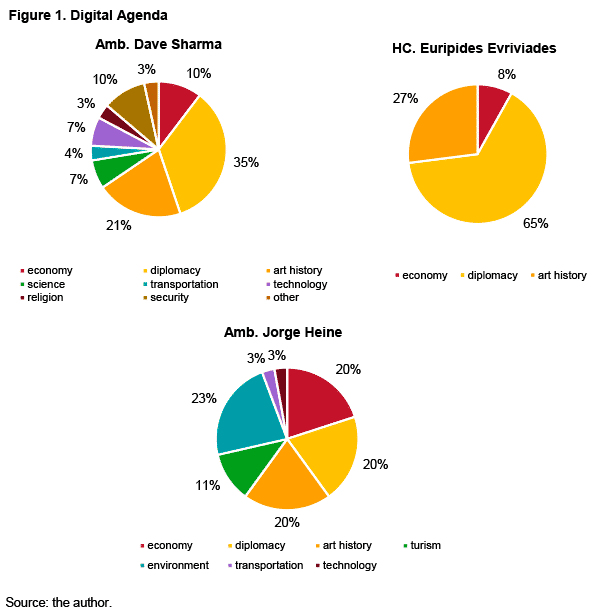
A key component of digital influence is the ‘network of networks’ that digital diplomats are expected to build and manage online so that they can firmly establish and enhance and their online presence. The “network of networks” may include policy makers, journalists, academics, diplomats, business people and diaspora leaders, who take an active interest in the positions and policies of the country represented by the embassy. The more diverse, the larger and the more connected these networks are, the stronger their ability to extend themselves in multiple configurations and by extension, the greater the influence of digital diplomats.8 From a network perspective, all three diplomats enjoy a rather diverse group of followers, but they seem to engage rather differently with their audience (see figure 2). Ambassador Sharma pays primary attention to the media, the High Commissioner Evriviades engages preferentially with fellow diplomats, while Ambassador Heine seems to enjoy the online company of academics. These approaches are reflective of the preferred strategies of each individual to develop his broader network of contacts and influencers by relying on a personal strength: communication skills in the case of Ambassador Sharma, networking abilities in the case of the High Commissioner Evriviades and a well-respected academic profile in the case of Ambassador Heine.
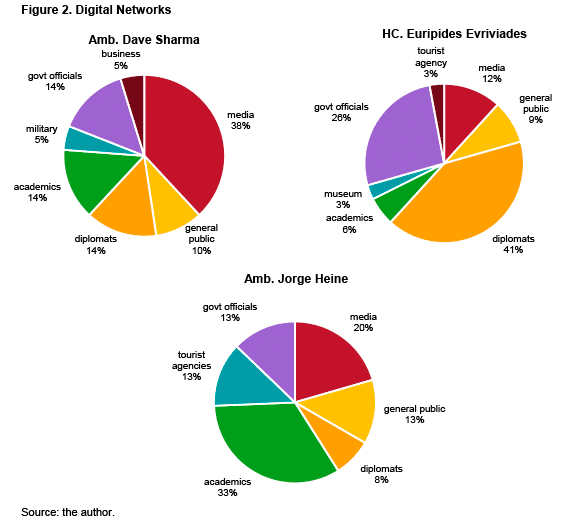
The digital style of the three diplomats is also important to examine as it may provide useful clues about the conditions for success or failure in adapting diplomatic communication to the characteristics of the digital medium discussed above. All three diplomats have clearly understood the importance of visuals in digital communication as they have relied on images for emphasising points in 60-80% of the time (see figure 3). To a lesser degree, they have also grasped the role of emotions, as illustrated by their moderate use of positive and occasionally uplifting language in their messages. Ambassador Sharma stands out for the use of humour and original tweets in his communication, an approach that resonates well with his audience. The High Commissioner Evriviades interestingly favours tweets with sophisticated intellectual content, which appears to serve the function of sending indirect signals to target audiences on controversial topics. Finally, Ambassador Heine is the only one that tweets bilingually, in English and Spanish, with the purpose of ensuring that the domestic audiences back home stay well informed about his diplomatic activity so that they continue supporting his mandate in the Chinese capital.
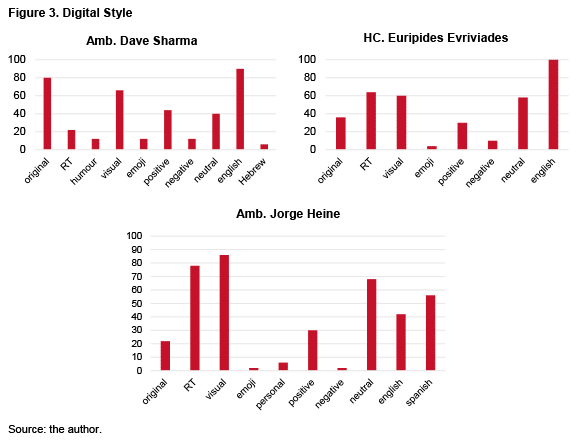
Conclusion
Echoing Secretary Kerry’s observation, we can conclude that the core mission of diplomacy in the Digital Age is still about finding the middle ground. What has changed is the context in which this mission is supposed to be accomplished as new digital technologies significantly broaden the spectrum of actors that can take part and influence the diplomatic conversation, reshape the “grammar rules” and institutional norms to guide online diplomatic engagement, and opens the door to the use of digital tools for disrupting the middle ground via disinformation and propaganda. As the three case studies have shown, successful digital diplomacy requires a keen understanding of the online space in which the digital diplomat operates, a competent strategy to building and managing a well-designed ‘network of networks’ of followers and influencers, and a pro-active approach to connecting digital diplomatic outputs to tangible foreign policy outcomes so that online influence could be successfully converted into offline diplomatic influence (actions and policies).
Dr. Corneliu Bjola
Head of the Oxford Digital Diplomacy Research Group (#DigDiploROx) | @CBjola
1 Kerry J. (2013), ‘Digital Diplomacy: Adapting Our Diplomatic Engagement’, DipNote U.S Department of State Official Blog, 6/V/2013, http://2007-2017-blogs.state.gov/stories/2013/05/06/digital-diplomacy-adapting-our-diplomatic-engagement.html
2 Dreischmeier, R., Close K., and Trichet, P. (2015), ‘The Digital Imperative’, Boston Consulting Group, 2/III/2015, https://www.bcgperspectives.com/content/articles/digital_economy_technology_strategy_digital_imperative/
3 Reinsel, D., Gantz J. and Rydning J. (2017), ‘Data Age 2025: The Evolution of Data to Life-Critical’, International Data Corporation, April 2017, https://www.seagate.com/www-content/our-story/trends/files/Seagate-WP-DataAge2025-March-2017.pdf
4 Siegler, MG. (2010), ‘Eric Schmidt: Every 2 Days We Create as Much Information as We Did up to 2003’, TechCrunch, https://techcrunch.com/2010/08/04/schmidt-data/
5 Bjola, C. (2017), ‘Digital diplomacy 2.0 pushes the boundary’, Global Times, 5/XI/2017, http://www.globaltimes.cn/content/1073667.shtml.
6 Bjola, C. (2018), ‘Propaganda in the digital age’, Global Affairs, no. 3 (3): 189.
7 The data for this study was collected in March 2017. Subsequent interviews with the three diplomats were conducted between April 2017-Sept 2018.
8 Bjola, C. (2018), ‘Digital Diplomacy From tactics to strategy’, The Berlin Journal, nr 32, Fall 2018, p. 78-81, https://www.americanacademy.de/wp-content/uploads/2018/09/20180926_Berlin-Journal-32-Fall-2018.pdf
